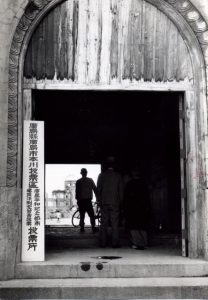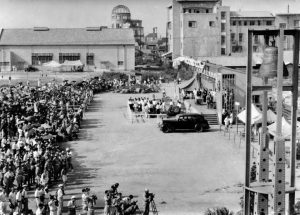Documenting Hiroshima 80 years after A-bombing: On August 6, 1949, Peace Memorial City Construction Law promulgated, bell made by survivors rung
Feb. 9, 2025
by Kyosuke Mizukawa, Senior Staff Writer
On August 6, 1949, four years after the atomic bombing, the Hiroshima Peace Memorial City Construction Law was promulgated and enacted. On that day, at the third Peace Festival held in Citizens Park in the area of Moto-machi (in the city’s present-day Naka Ward), Hiroshima City Mayor Shinso Hamai delivered the Peace Declaration. Referring to the promulgation and enactment of the law, he proclaimed, “Let us join in renouncing war forever, and build the idea of world peace on this earth.”
Importance of Article 6
The aforementioned law’s Article 3 stipulates that the national government and others should render “every possible assistance” for Hiroshima to become a city symbolic of everlasting peace. Article 6 of the law highlights the mayor’s obligation to engage in “unceasing action” toward achievement of the Peace Memorial City “in cooperation with citizens.”
Tadashi Teramitsu, then secretary-general of Japan’s upper House of Councilors who was involved in the drafting of the bill, explained the importance of Article 6 in his explanatory booklet Hiroshima Heiwa Toshiho (in English, ‘Hiroshima Peace City Law’), published in 1949. “The more proactive the mayor of Hiroshima is, the more effective it and Article 3 will be, functioning in proportion to the mayor’s intensity.”
In August, the city launched a campaign to collect signatures for a peace petition to heighten and unify public opinion behind the idea of seeking peace. The petition aimed to strengthen the United Nations and create a robust world organization that could prevent future wars, as citizens of Hiroshima, who had experienced the world’s first atomic bombing in wartime. The petition was addressed to U.S. President Harry S. Truman.
The campaign was recommended to the city government by Reverend Kiyoshi Tanimoto, an A-bomb survivor who had traveled across the United States starting in the fall of 1948 to speak about the devastation of Hiroshima. It is said that local journalists suggested he initiate such a campaign. In light of the tragedy of World War II, a movement to establish a worldwide federation to overcome conflicts among nations leading to war had been spreading mainly in Europe and the United States.
Procure materials at one’s own expense
In 1949, under the slogan “No More Hiroshimas,” an event was held marked by churches ringing bells for peace in San Francisco, New York, and other cities at the moment the atomic bomb was dropped on Hiroshima, as an extension of the movement of prayers for world peace that had begun the previous year on August 6. At Hiroshima’s Peace Festival, a new Peace Bell inscribed with the phrase No More Hiroshimas in English was also rung.
The Peace Bell was fashioned in a Western style and stood 1.4 meters in height. It was hung from an approximately nine-meter, steel-frame belfry. Hiromi Takato, 79, a resident of Hiroshima’s Saeki Ward who is familiar with its history, said, “Made by local A-bomb survivors, I believe the bell was truly fitting for the ceremony in Hiroshima.”
In the first and second festival ceremonies, a bell that had been sold off by the former Japan Imperial Navy had been used. Meanwhile, for the third such ceremony, the Hiroshima Copper Alloy Cast Association, comprised of local casting manufacturers, had produced a bell and donated it to the city on August 5.
“Along with the union of manufacturers who survived the atomic bombing, we want to make a bell that commemorates the passage of the Peace Memorial City Construction Law by the parliamentary Diet,” stated Yonekichi Matsumura, president of the Copper Alloy Cast Association, as reported in the Chugoku Shimbun dated June 23. The union members collected materials at their own expense, going so far as to use metals that had remained in the scorched ruins.
The Peace Bell remains at its original location, in what is now called Hiroshima Gate Park. The bell is not used in the city’s Peace Memorial Ceremony, but the citizen’s group Resonate! Peace Bell Executive Committee, led by Mr. Takato, holds a prayer ceremony in August during which participants ring the bell.
(Originally published on February 9, 2025)
On August 6, 1949, four years after the atomic bombing, the Hiroshima Peace Memorial City Construction Law was promulgated and enacted. On that day, at the third Peace Festival held in Citizens Park in the area of Moto-machi (in the city’s present-day Naka Ward), Hiroshima City Mayor Shinso Hamai delivered the Peace Declaration. Referring to the promulgation and enactment of the law, he proclaimed, “Let us join in renouncing war forever, and build the idea of world peace on this earth.”
Importance of Article 6
The aforementioned law’s Article 3 stipulates that the national government and others should render “every possible assistance” for Hiroshima to become a city symbolic of everlasting peace. Article 6 of the law highlights the mayor’s obligation to engage in “unceasing action” toward achievement of the Peace Memorial City “in cooperation with citizens.”
Tadashi Teramitsu, then secretary-general of Japan’s upper House of Councilors who was involved in the drafting of the bill, explained the importance of Article 6 in his explanatory booklet Hiroshima Heiwa Toshiho (in English, ‘Hiroshima Peace City Law’), published in 1949. “The more proactive the mayor of Hiroshima is, the more effective it and Article 3 will be, functioning in proportion to the mayor’s intensity.”
In August, the city launched a campaign to collect signatures for a peace petition to heighten and unify public opinion behind the idea of seeking peace. The petition aimed to strengthen the United Nations and create a robust world organization that could prevent future wars, as citizens of Hiroshima, who had experienced the world’s first atomic bombing in wartime. The petition was addressed to U.S. President Harry S. Truman.
The campaign was recommended to the city government by Reverend Kiyoshi Tanimoto, an A-bomb survivor who had traveled across the United States starting in the fall of 1948 to speak about the devastation of Hiroshima. It is said that local journalists suggested he initiate such a campaign. In light of the tragedy of World War II, a movement to establish a worldwide federation to overcome conflicts among nations leading to war had been spreading mainly in Europe and the United States.
Procure materials at one’s own expense
In 1949, under the slogan “No More Hiroshimas,” an event was held marked by churches ringing bells for peace in San Francisco, New York, and other cities at the moment the atomic bomb was dropped on Hiroshima, as an extension of the movement of prayers for world peace that had begun the previous year on August 6. At Hiroshima’s Peace Festival, a new Peace Bell inscribed with the phrase No More Hiroshimas in English was also rung.
The Peace Bell was fashioned in a Western style and stood 1.4 meters in height. It was hung from an approximately nine-meter, steel-frame belfry. Hiromi Takato, 79, a resident of Hiroshima’s Saeki Ward who is familiar with its history, said, “Made by local A-bomb survivors, I believe the bell was truly fitting for the ceremony in Hiroshima.”
In the first and second festival ceremonies, a bell that had been sold off by the former Japan Imperial Navy had been used. Meanwhile, for the third such ceremony, the Hiroshima Copper Alloy Cast Association, comprised of local casting manufacturers, had produced a bell and donated it to the city on August 5.
“Along with the union of manufacturers who survived the atomic bombing, we want to make a bell that commemorates the passage of the Peace Memorial City Construction Law by the parliamentary Diet,” stated Yonekichi Matsumura, president of the Copper Alloy Cast Association, as reported in the Chugoku Shimbun dated June 23. The union members collected materials at their own expense, going so far as to use metals that had remained in the scorched ruins.
The Peace Bell remains at its original location, in what is now called Hiroshima Gate Park. The bell is not used in the city’s Peace Memorial Ceremony, but the citizen’s group Resonate! Peace Bell Executive Committee, led by Mr. Takato, holds a prayer ceremony in August during which participants ring the bell.
(Originally published on February 9, 2025)









